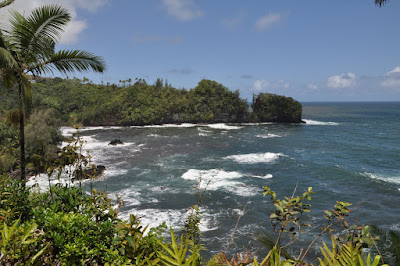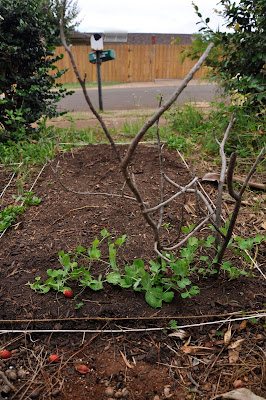Not a food forest, but a beautiful forest, nonetheless. A fallen log consumed by other life.
I spent time creating a plant list, full of fruits, perennials, bushes, trees, etc. that could provide a variety and abundance in a small scale backyard garden. Finding all the pieces and then putting it together makes for quite a complex puzzule to be assembled. In doing research, you find may find even more useful plants that you never heard about. Some are not typical in your region, or not commonly used as foods. Others, you can't use, due to climate or legal restrictions. Others, for practicality sake, are simply not feasable (too big, yield not worth effort, no market, etc.), but all are worth considering.
A view of Hilo bay on a typical rainy day. A baby pineapple in my uncle's yard.
I also spent time to make a resource list of further readings. As I read, I learn that there is much more to read, and it becomes endless. You could spend all your time reading about a subject that should be hands on. Reading, however valuable and necessary, won't put food on the table.
That said, I was ready to come back and start working in the yard. I went to Kula Hardware to look around at what they had in stock. I was surprised to see all kinds of fruit trees there. Here's a incomprehensive list (to be sure, as I am interested in the food production, I only noticed those types of plants): apricots, mangoes, lemons, limes, tangerines, oranges, pears (4 cultivars on one plant), about 5 diffeent avocados, walnuts, soursops, starfruit, jaboticaba, abiu, and others. I had never even heard of some of them.
This nursery has been my best source for all kinds of stuff. I suggest that if you live on Maui, you check them out. They have a good variety of native and exotic plants, organic supplies, seeds, etc. You will be surprised everytime you go there. They're really knowledgeable too.
Update:
We'll start with the bad news. The tomatoes that I had initially planted about a month ago have perished. The seedlings were attacked by some bug in the night. Some onion and shallot seedlings have also gone to dust. Bell peppers never got above ground, same with chamomile. But now I know not to start seeds directly in the ground. I will have a staging period in small pots or on a table-like seeding bed, then transplant when healthy and vigorous enough to fend for itself. Ugh, that was painful. Okay, that's over. Now for the good news.
Top left to rt: just purchased blueberry bush (about a month ago); blue berry bush today; peas w/ stick trellis;
Bottom left to rt: revived kalo; compost pile;
All other things are doing well. The peas are nice and healthy, although slightly bullet riddled. The taro, which seemed to have a bleak outlook, is now doing well. It is vibrant green, with many small keiki (small offshoots). I think adding mulch, nitrogen, and more water, helped that baby along. The blueberry bush is bangin'. Lots of new growth, fresh and full of color. Same with the lime tree. Until a while ago, it seemed to be stagnant. But with pruning and extra water, it now has aromatic new leaves. And hopefully fruit soon. Got a compost pile goin, sheet mulch is still goin well. And I am excited to announce a new addition today... I now have worms. This is another weapon in my arsenal against pest and disease. Not to mention the decrease in waste that must leave our house. Paper and food scraps no longer go to the landfill, they can stay with us.Bottom left to rt: revived kalo; compost pile;
Lastly, after a rigorous application and interview process, I was deemed worthy to take part in the CTAHR Master Gardener program here on Maui. I am ecstatic and associate self-worth to being accepted. We will learn a variety of subjects related to gardening, and after "graduation" from the 13-week course, will be a master gardener. You, too, may become a master gardener, but only if you're cool
A site that I find very useful for my particular location is the College of Tropical Agriculture and Human Resources (CTAHR) of the Univ. of Hawaii. They have useful information for Hawaii related plants, climates, research, questions, and problems.
Pictures to come soon.














No comments:
Post a Comment